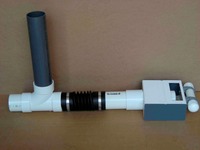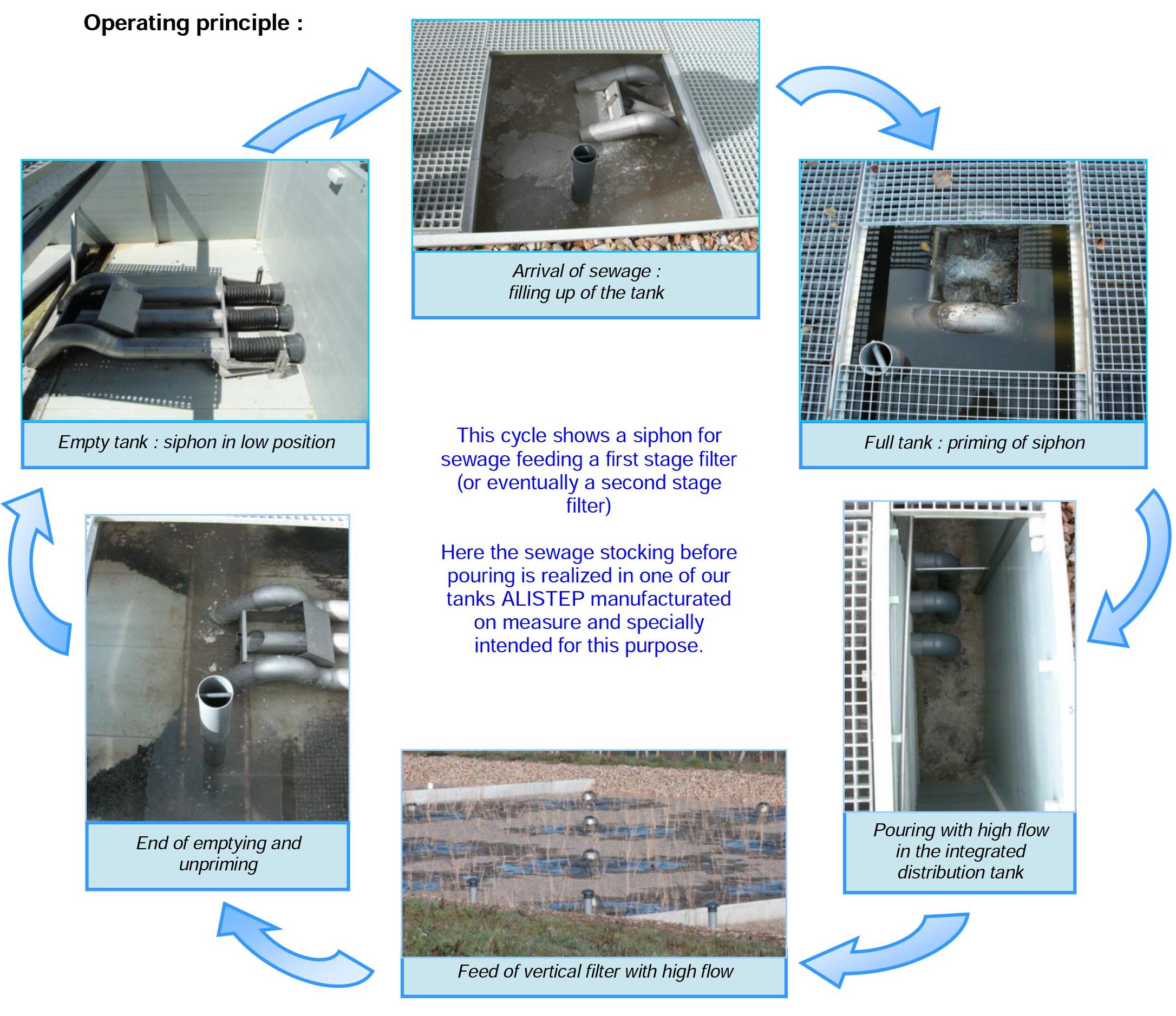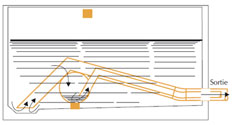- Forum
- categories
- Sanitation systems
- Faecal sludge management (FSM)
- Faecal sludge treatment technologies
- Any successful experience with siphon system?
Any successful experience with siphon system?
24.9k views
- AlexandraDubois
-
 Topic Author
Topic Author- Administrator
- Technical advisor specialized in water, sanitation and hygiene. I work for GIZ since 2012 and have gathered experience in the sub-Saharan region mainly. Since January 2022, I work as an advisor for the “Water Policy Sector Programme - Innovations for Resilience” in Bonn and I am part of the SuSanA secretariat.
Less- Posts: 65
- Karma: 6
- Likes received: 46
Dear Krishan, Christophe and Detlef
Thank you for your answers. I agree that the siphon bell might not be ideal for sludge (due to the steep angles of the fittings) however it is by far the simplest/cheapest solution we have. We have looked into other designs, for example the floating valve, or the tipping bucket, etc. But it was either too complicated to fabricate locally and implement at large scale or not suitable for the amount of effluent we want to flush. Regarding the pump option, unfortunately, not all the DTF site will have a connection to electricity, and using solar panel would involve very expensive batteries to store and provide sufficient power to the pump.
Therefore we have decided for the bell siphon. We are hoping that by the time it reaches the Constructed Wetland, the treated effluent will not be so thick anymore (pre treatment includes a settler and an anaerobic baffled reactor). We have successfully installed and tested our first bell siphon in one of our DTF in Embu. You can check at the video we took during the test:
The siphon allows 1 flush of 1.5 m3 every 1.30 hour. From the test (as well as from your comments) we have decided to further improve the product by adding a framed sieve around the bell opening (between the base slab and the bell edge) to avoid coarse material to either enter the pipe or clog the bell opening. Our next model will also allow dismantling of the fitting to enable cleaning of the pipes. Once the DTF will be commissioned, I will keep you updated on the success (or not) of the siphon in real conditions.
I wish you all a very nice day
PS: please find below some pictures of the siphon installation in Embu:
Thank you for your answers. I agree that the siphon bell might not be ideal for sludge (due to the steep angles of the fittings) however it is by far the simplest/cheapest solution we have. We have looked into other designs, for example the floating valve, or the tipping bucket, etc. But it was either too complicated to fabricate locally and implement at large scale or not suitable for the amount of effluent we want to flush. Regarding the pump option, unfortunately, not all the DTF site will have a connection to electricity, and using solar panel would involve very expensive batteries to store and provide sufficient power to the pump.
Therefore we have decided for the bell siphon. We are hoping that by the time it reaches the Constructed Wetland, the treated effluent will not be so thick anymore (pre treatment includes a settler and an anaerobic baffled reactor). We have successfully installed and tested our first bell siphon in one of our DTF in Embu. You can check at the video we took during the test:
The siphon allows 1 flush of 1.5 m3 every 1.30 hour. From the test (as well as from your comments) we have decided to further improve the product by adding a framed sieve around the bell opening (between the base slab and the bell edge) to avoid coarse material to either enter the pipe or clog the bell opening. Our next model will also allow dismantling of the fitting to enable cleaning of the pipes. Once the DTF will be commissioned, I will keep you updated on the success (or not) of the siphon in real conditions.
I wish you all a very nice day
PS: please find below some pictures of the siphon installation in Embu:
Alexandra Dubois
Technical Advisor
Sector Programme Water Policy – Innovations for Resilience
Division Climate Change, Environment & Infrastructure
GIZ │Deutsche Gesellschaft für
Internationale Zusammenarbeit (GIZ) GmbH
Friedrich-Ebert-Allee 32
53113 Bonn, Germany
Technical Advisor
Sector Programme Water Policy – Innovations for Resilience
Division Climate Change, Environment & Infrastructure
GIZ │Deutsche Gesellschaft für
Internationale Zusammenarbeit (GIZ) GmbH
Friedrich-Ebert-Allee 32
53113 Bonn, Germany
Attachments:
-
 IMG_201604...3052.jpg
(Filesize: 48KB)
IMG_201604...3052.jpg
(Filesize: 48KB)
-
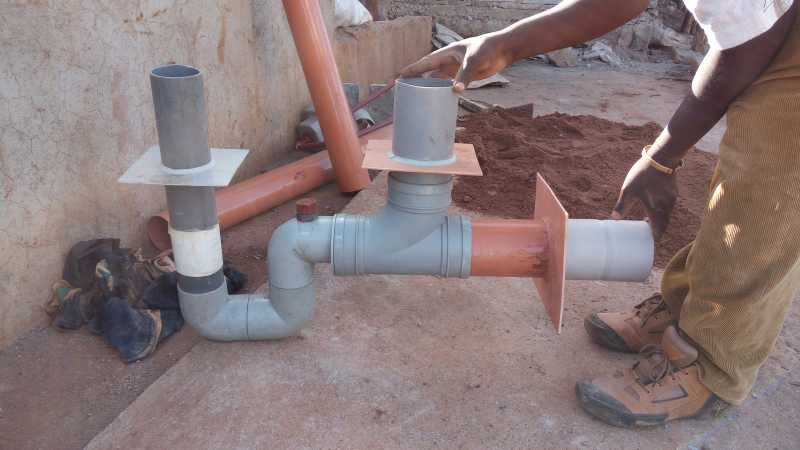 IMG_201604...4053.jpg
(Filesize: 33KB)
IMG_201604...4053.jpg
(Filesize: 33KB)
-
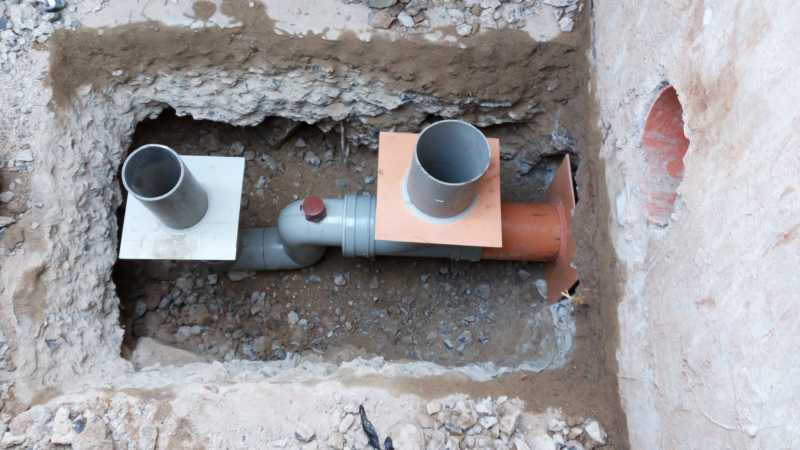 IMG_201604...0017.jpg
(Filesize: 40KB)
IMG_201604...0017.jpg
(Filesize: 40KB)
-
 IMG_201604...3925.jpg
(Filesize: 25KB)
IMG_201604...3925.jpg
(Filesize: 25KB)
-
 IMG_201604...4146.jpg
(Filesize: 31KB)
IMG_201604...4146.jpg
(Filesize: 31KB)
-
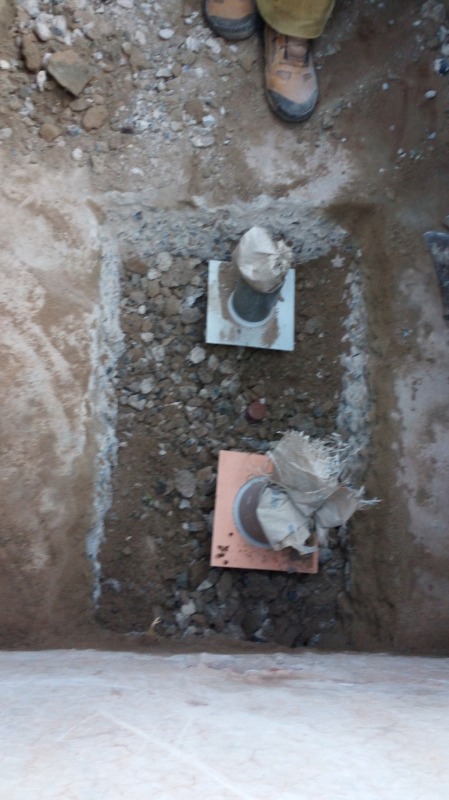 IMG_201604...2028.jpg
(Filesize: 104KB)
IMG_201604...2028.jpg
(Filesize: 104KB)
-
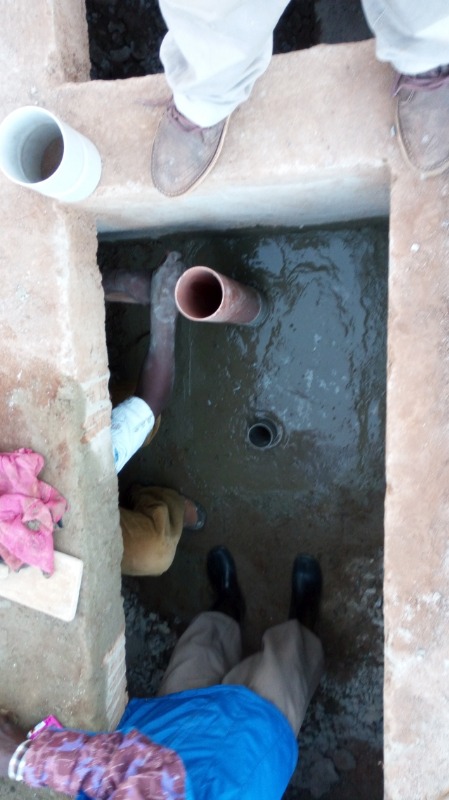 IMG_201604...2110.jpg
(Filesize: 98KB)
IMG_201604...2110.jpg
(Filesize: 98KB)
The following user(s) like this post: JKMakowka, jens, chamia
Please Log in to join the conversation.
You need to login to reply
Hallo Alexandra,
Only today I came across your technical siphon-problem.
In an old 2014 postings at susana-forum you can find a SIMPLE siphon system (open source) for "pre- treated sewage", you may "copy & paste" this system at your Kenyan workshop (siphon 50 mm diameter up to 12 p.e. CW; 2x 75 mm diameter up to 25 p.e. CW:
Simple device to deliver water to CW in interval without external power needs or electronic gadgets "Open Design"
developed years ago by former "Ingenieurbüro für Abwassertechnik" of Dipl.-Ing. Herbert Reppert
The pressure head need between the siphon outlet and the bed surface is about 0,3 m.
Commercial products for "pre- treated sewage" flouting valves:
in Austria
in France
in USA
Commercial products for "raw sewage" siphon from 2 French companies
ALISTEP
The pressure head need between the siphon outlet and the bed surface is about 0,3 - 0,5 m.
and
SINT
The pressure head need between the siphon outlet and the bed surface is about 1 - 1,5 m.
I hope you got an overview to make your own siphon or floating valve decision?
The advantage of a siphon system (in my personal opinion) is a faster distribution of sewage via distribution pipework of CW, in order to ensure equal distribution to filter surface.
I regret, I do not recommend your tested "bell siphon system", it might work for clear water good, but this system is not simple/rough enough for accumulating dirt by pre-treated sewage. For sure you will find out by your self
Regards,
Detlef
Only today I came across your technical siphon-problem.
In an old 2014 postings at susana-forum you can find a SIMPLE siphon system (open source) for "pre- treated sewage", you may "copy & paste" this system at your Kenyan workshop (siphon 50 mm diameter up to 12 p.e. CW; 2x 75 mm diameter up to 25 p.e. CW:
Simple device to deliver water to CW in interval without external power needs or electronic gadgets "Open Design"
developed years ago by former "Ingenieurbüro für Abwassertechnik" of Dipl.-Ing. Herbert Reppert
The pressure head need between the siphon outlet and the bed surface is about 0,3 m.
Commercial products for "pre- treated sewage" flouting valves:
in Austria
in France
in USA
Commercial products for "raw sewage" siphon from 2 French companies
ALISTEP
The pressure head need between the siphon outlet and the bed surface is about 0,3 - 0,5 m.
and
SINT
The pressure head need between the siphon outlet and the bed surface is about 1 - 1,5 m.
I hope you got an overview to make your own siphon or floating valve decision?
The advantage of a siphon system (in my personal opinion) is a faster distribution of sewage via distribution pipework of CW, in order to ensure equal distribution to filter surface.
I regret, I do not recommend your tested "bell siphon system", it might work for clear water good, but this system is not simple/rough enough for accumulating dirt by pre-treated sewage. For sure you will find out by your self
Regards,
Detlef
www.aqua-verde.de, AquaVerde Ltd. Zanzibar
"simple" Sanitation-Solutions by gravity
Low-Tech Solutions with High-Tech Effects
"Inspired by Circular Economy and Cooperation"
www.flickr.com/photos/aqua-verde/
"simple" Sanitation-Solutions by gravity
Low-Tech Solutions with High-Tech Effects
"Inspired by Circular Economy and Cooperation"
www.flickr.com/photos/aqua-verde/
Attachments:
-
 pfl-beetRo...eich.jpg
(Filesize: 23KB)
pfl-beetRo...eich.jpg
(Filesize: 23KB)
-
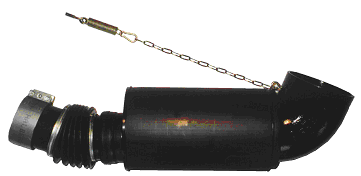 Rohrventil...eich.gif
(Filesize: 8KB)
Rohrventil...eich.gif
(Filesize: 8KB)
The following user(s) like this post: Marijn Zandee, JKMakowka, chamia
Please Log in to join the conversation.
You need to login to reply
Here is what I would try (untested!) in a low resource setting only using simple off the shelf materials available in most better hardware stores around the world:
Larger (4"?) diameter gently sloped (45° elbows) PVC sanitary pipe with both ends submerged in water, one obviously a bit lower to allow for the siphon effect to work. All joints must be solvent cemented carefully and covering them with silicone or epoxy for extra air-tightness will be probably be helpful.
Then heat-weld or glue a 1" PVC pipe to a small hole on the top of the siphon and attach an electric self-priming well pump to that (1/2hp should do). One of those easy to clean-out nylon-mesh filters will probably be useful to avoid maintenance problems of that pump.
Then attach a common float switch to that pump that starts the pump as soon as it becomes submerged in water and suspend it at the hight you want your siphon to start. The flexibility of that will make it very easy to adjust/optimize the amount of water flushed.
Once you holding tank reaches the desired water level, the float switch will start the suction-pump, which will in turn suck air/water from both sides of the siphon until the pipe is fully filled. At that point the siphon will start, the water level drop and the suction-pump will turn off due to the float-switch falling dry. Depending on the size of you holding tank the pump will probably not turn off immediately, but it should manage to pump a bit of waste-water without problem and thus also stabilize the siphon effect (and refill itself for the next self-priming event).
Then at some later time the higher side of the siphon will start sucking air and the effect breaks until the next cycle.
All in all that should be easily build-able for around 100€ based on Philippine prices levels and except for the need of electricity supply it should be much more fail-proof and easier to replicate as well.
Edit: the main siphon pipe should not have too much lift or a very big diameter, as otherwise the self-priming of the well pump will run into problems. If 4" doesn't do the trick, maybe 3" will. if 4" works fine, try 6" or 2x4" for faster drainage.
Larger (4"?) diameter gently sloped (45° elbows) PVC sanitary pipe with both ends submerged in water, one obviously a bit lower to allow for the siphon effect to work. All joints must be solvent cemented carefully and covering them with silicone or epoxy for extra air-tightness will be probably be helpful.
Then heat-weld or glue a 1" PVC pipe to a small hole on the top of the siphon and attach an electric self-priming well pump to that (1/2hp should do). One of those easy to clean-out nylon-mesh filters will probably be useful to avoid maintenance problems of that pump.
Then attach a common float switch to that pump that starts the pump as soon as it becomes submerged in water and suspend it at the hight you want your siphon to start. The flexibility of that will make it very easy to adjust/optimize the amount of water flushed.
Once you holding tank reaches the desired water level, the float switch will start the suction-pump, which will in turn suck air/water from both sides of the siphon until the pipe is fully filled. At that point the siphon will start, the water level drop and the suction-pump will turn off due to the float-switch falling dry. Depending on the size of you holding tank the pump will probably not turn off immediately, but it should manage to pump a bit of waste-water without problem and thus also stabilize the siphon effect (and refill itself for the next self-priming event).
Then at some later time the higher side of the siphon will start sucking air and the effect breaks until the next cycle.
All in all that should be easily build-able for around 100€ based on Philippine prices levels and except for the need of electricity supply it should be much more fail-proof and easier to replicate as well.
Edit: the main siphon pipe should not have too much lift or a very big diameter, as otherwise the self-priming of the well pump will run into problems. If 4" doesn't do the trick, maybe 3" will. if 4" works fine, try 6" or 2x4" for faster drainage.
The following user(s) like this post: chamia
Please Log in to join the conversation.
You need to login to reply
Seems like a system that works quite well with clear water, but what is the effective diameter the water has to pass through and how many sharp angles are in there that might allow things to get stuck? What about floating substances?
I guess with a very consistent pre-treatment and/or maybe a roughing filter + safe overflows in case of something going wrong, it might work quite ok.
I guess with a very consistent pre-treatment and/or maybe a roughing filter + safe overflows in case of something going wrong, it might work quite ok.
Please Log in to join the conversation.
You need to login to reply
Dear Alexandra,
we have used the siphon you demonstrated in the video. It is very easy to build with just PVC Pipes of different diameters and the accessories. From what I remember (it has been 5 years ago) we had to play around to find out the optimal distances of the overlapping between the Hut (larger pipe) and the upper rim of the inlet tube. We used it in several wetlands to feed the vertical stage after pretreatment. The point is to get right the elevation of water in order to have a sufficient resting time between pulses. The pressure head between the siphon and the bed was about 1,2 m. Less is not good due to the need of a pressure loss in the hole of the distribution pipes.
We stopped using it as a commercial application as it is a hazel to get it right and we did not have a demand for a fabrication, but for sure it works quite well, the plants have been working ever since and very little problems... just sometimes if there is a problem with a insufficient pretreatment. Pumps are simply easier to use and make the installation more flexible as the number of installations with a possible head loss of 1,2 ist not very large.
Regards
Christoph
we have used the siphon you demonstrated in the video. It is very easy to build with just PVC Pipes of different diameters and the accessories. From what I remember (it has been 5 years ago) we had to play around to find out the optimal distances of the overlapping between the Hut (larger pipe) and the upper rim of the inlet tube. We used it in several wetlands to feed the vertical stage after pretreatment. The point is to get right the elevation of water in order to have a sufficient resting time between pulses. The pressure head between the siphon and the bed was about 1,2 m. Less is not good due to the need of a pressure loss in the hole of the distribution pipes.
We stopped using it as a commercial application as it is a hazel to get it right and we did not have a demand for a fabrication, but for sure it works quite well, the plants have been working ever since and very little problems... just sometimes if there is a problem with a insufficient pretreatment. Pumps are simply easier to use and make the installation more flexible as the number of installations with a possible head loss of 1,2 ist not very large.
Regards
Christoph
Please Log in to join the conversation.
You need to login to reply- AlexandraDubois
-
 Topic Author
Topic Author- Administrator
- Technical advisor specialized in water, sanitation and hygiene. I work for GIZ since 2012 and have gathered experience in the sub-Saharan region mainly. Since January 2022, I work as an advisor for the “Water Policy Sector Programme - Innovations for Resilience” in Bonn and I am part of the SuSanA secretariat.
Less- Posts: 65
- Karma: 6
- Likes received: 46
Dear all, thank you for your input, I might not have replied to all of your posts but I took all your suggestions into consideration while trying to sort out the siphon issue. As I have mentioned in my former post, the team and I have realized very quickly that our simple U shape siphon design would not work (specifically regarding the self-starting option that we are looking for). Therefore we decided to work on other designs. The main requirements we were looking at for the new design were:
After some thorough research we came across this video:
Together with our local supplier (Ironmongers) we developed and constructed a prototype largely based on the design showcased in the video. To see the test video of our bell siphon prototype see here:
The finished product should follow soon. We will keep you updated.
Kind regards from Nairobi
- should be simple enough to be fabricated locally at a low cost
- should require a minimal head elevation difference (less than 1.4m)
- should enable a maximum of 14 flush per day (meaning a minimum of 1.5L per flush)
After some thorough research we came across this video:
Together with our local supplier (Ironmongers) we developed and constructed a prototype largely based on the design showcased in the video. To see the test video of our bell siphon prototype see here:
The finished product should follow soon. We will keep you updated.
Kind regards from Nairobi
Alexandra Dubois
Technical Advisor
Sector Programme Water Policy – Innovations for Resilience
Division Climate Change, Environment & Infrastructure
GIZ │Deutsche Gesellschaft für
Internationale Zusammenarbeit (GIZ) GmbH
Friedrich-Ebert-Allee 32
53113 Bonn, Germany
Technical Advisor
Sector Programme Water Policy – Innovations for Resilience
Division Climate Change, Environment & Infrastructure
GIZ │Deutsche Gesellschaft für
Internationale Zusammenarbeit (GIZ) GmbH
Friedrich-Ebert-Allee 32
53113 Bonn, Germany
The following user(s) like this post: JKMakowka, chamia
Please Log in to join the conversation.
You need to login to reply- YoviToni
-
 Less
Less- Posts: 6
- Karma: 1
- Likes received: 2
HI Alexandra,
The problem of why your system doesn’t work is the cavitation phenomenon, the formation of air bubble inside the pipe. To fix the problem, just change your U-pipe with T-pipe like in the septic tank. Or if you keep using this U-pipe, make a big hole in the upper of inlet side of U-pipe to prevent the air trapped which cause the cavitation or cut the inlet side, so the water doesn’t fully fill the pipe.
Hopeful it works.
Yovianus Toni
Edit:
Hi Forum,
I just realised that my suggestion is out of context on the case that need to regulate the flow.
Sorry for the inconvenience and just ignore mine.
The problem of why your system doesn’t work is the cavitation phenomenon, the formation of air bubble inside the pipe. To fix the problem, just change your U-pipe with T-pipe like in the septic tank. Or if you keep using this U-pipe, make a big hole in the upper of inlet side of U-pipe to prevent the air trapped which cause the cavitation or cut the inlet side, so the water doesn’t fully fill the pipe.
Hopeful it works.
Yovianus Toni
Edit:
Hi Forum,
I just realised that my suggestion is out of context on the case that need to regulate the flow.
Sorry for the inconvenience and just ignore mine.
The following user(s) like this post: Doreen
Please Log in to join the conversation.
You need to login to reply
I agree that building one of these hydro mechanical syphons might require too much trail and error to get working reliably. Besides there are also patent issues it seems.
The systems I have seen so far all used high capacity sludge pumps so that is probably the easiest.
I think however that a small vacuum pump operated with a suspended float switch could be relatively easy to build. Maybe worth a try before dismantling the current system?
The systems I have seen so far all used high capacity sludge pumps so that is probably the easiest.
I think however that a small vacuum pump operated with a suspended float switch could be relatively easy to build. Maybe worth a try before dismantling the current system?
Please Log in to join the conversation.
You need to login to reply
Hi Alexandra,
I much agree with what Kirschan said.
Here a link to a company supplying a syphon like the one mentionned by Krischan: www.alistep.com/our-equipment/float-operated-flush/?lang=en
There are other similar designs available, mainly from French companies.
They are commonly used in France and other countries for rural constructed wetlands
For a first application in a country, I'd recommend to order a ready made syphon from one of these suppliers. Getting them right just from drawings or photos is not so easy...
Of course instead of a syphon you can also use a (strong) pump. Obviously it's good to try to try to avoid pumps and have gravtiy flow only, but this is not always possible, and if you need pumping anyway, you can use it to feed the wetlands from a holding tank.
Best, Florian
I much agree with what Kirschan said.
Here a link to a company supplying a syphon like the one mentionned by Krischan: www.alistep.com/our-equipment/float-operated-flush/?lang=en
There are other similar designs available, mainly from French companies.
They are commonly used in France and other countries for rural constructed wetlands
For a first application in a country, I'd recommend to order a ready made syphon from one of these suppliers. Getting them right just from drawings or photos is not so easy...
Of course instead of a syphon you can also use a (strong) pump. Obviously it's good to try to try to avoid pumps and have gravtiy flow only, but this is not always possible, and if you need pumping anyway, you can use it to feed the wetlands from a holding tank.
Best, Florian
The following user(s) like this post: JKMakowka
Please Log in to join the conversation.
You need to login to reply- AlexandraDubois
-
 Topic Author
Topic Author- Administrator
- Technical advisor specialized in water, sanitation and hygiene. I work for GIZ since 2012 and have gathered experience in the sub-Saharan region mainly. Since January 2022, I work as an advisor for the “Water Policy Sector Programme - Innovations for Resilience” in Bonn and I am part of the SuSanA secretariat.
Less- Posts: 65
- Karma: 6
- Likes received: 46
Dear Krischan
Thank you so much for your answer.
Kindly, don't take too much of your time analysing the drawing. At the moment the siphon is nothing else that two pipe bends connected with a 150mm PVC pipe (no elevation head difference between inlet and outlet). The objective of my post was to know if there was any successful experience with siphon that could help us in modifying our design. To answer your question, to my knowledge (the concept was developed 2 years before my arrival) the design was not adapted from somewhere, but developed from theory and it has not been tested before.
I am very much interested in the hydromechanical siphon model you have suggested. Do you know if it has been implemented somewhere? Have you ever seen it working? Is there any open source drawings available?
Thank you very much and warm regards from Nairobi
Thank you so much for your answer.
Kindly, don't take too much of your time analysing the drawing. At the moment the siphon is nothing else that two pipe bends connected with a 150mm PVC pipe (no elevation head difference between inlet and outlet). The objective of my post was to know if there was any successful experience with siphon that could help us in modifying our design. To answer your question, to my knowledge (the concept was developed 2 years before my arrival) the design was not adapted from somewhere, but developed from theory and it has not been tested before.
I am very much interested in the hydromechanical siphon model you have suggested. Do you know if it has been implemented somewhere? Have you ever seen it working? Is there any open source drawings available?
Thank you very much and warm regards from Nairobi
Alexandra Dubois
Technical Advisor
Sector Programme Water Policy – Innovations for Resilience
Division Climate Change, Environment & Infrastructure
GIZ │Deutsche Gesellschaft für
Internationale Zusammenarbeit (GIZ) GmbH
Friedrich-Ebert-Allee 32
53113 Bonn, Germany
Technical Advisor
Sector Programme Water Policy – Innovations for Resilience
Division Climate Change, Environment & Infrastructure
GIZ │Deutsche Gesellschaft für
Internationale Zusammenarbeit (GIZ) GmbH
Friedrich-Ebert-Allee 32
53113 Bonn, Germany
Please Log in to join the conversation.
You need to login to reply
About the siphon:
The drawing attached does not give much details, but it seems it is just a reversed U bend pipe? Is this a proven design adapted from somewhere?
I am not an expert on this, but my impression from similar structures in water supply engineering is that you need a vacuum pump to suck the air out of the top of such a reserved U in order for the siphon effect to work.
In wetland construction there is also what is called a hydromechanical siphon (we discussed it here in the forum before but I can't find the thread), that functions quite a bit different. It has a movable inlet pipe with a float that at some point fills with water and then it drops and enables a siphon effect to take place that flushes the tank. This good document has a short description and two photos of an example on page 30(41):
www.sswm.info/sites/default/files/refere...etlands%20Manual.pdf
The drawing attached does not give much details, but it seems it is just a reversed U bend pipe? Is this a proven design adapted from somewhere?
I am not an expert on this, but my impression from similar structures in water supply engineering is that you need a vacuum pump to suck the air out of the top of such a reserved U in order for the siphon effect to work.
In wetland construction there is also what is called a hydromechanical siphon (we discussed it here in the forum before but I can't find the thread), that functions quite a bit different. It has a movable inlet pipe with a float that at some point fills with water and then it drops and enables a siphon effect to take place that flushes the tank. This good document has a short description and two photos of an example on page 30(41):
www.sswm.info/sites/default/files/refere...etlands%20Manual.pdf
Please Log in to join the conversation.
You need to login to reply- AlexandraDubois
-
 Topic Author
Topic Author- Administrator
- Technical advisor specialized in water, sanitation and hygiene. I work for GIZ since 2012 and have gathered experience in the sub-Saharan region mainly. Since January 2022, I work as an advisor for the “Water Policy Sector Programme - Innovations for Resilience” in Bonn and I am part of the SuSanA secretariat.
Less- Posts: 65
- Karma: 6
- Likes received: 46
Dear DTF community
GIZ Water Programme Kenya is currently supporting the Water Services Trust Fund (partner organisation) with the implementation of an Upscaling Sanitation project (see SuSanA forum post here ) including the construction of standard DTF to treat faecal sludge collected from septic/conservancy tank by exhauster all over the country. To start with, we are aiming at achieving our pilot DTF located in Embu town. GIZ and WSTF are supporting the local water company to implement the DTF which includes the following treatment modules:
1. Receiving bay / Balancing tank (RBBT)
2. Settler (ST)
3. Anaerobic Baffled Reactor (ABR)
4. Vertical Flow Constructed Wetland (VFCW)
(Structural drawings available here[/url])
The maximum capacity of the DTF is 22m3/d with a continuous discharge of 2m3/h during a maximum period of 12h (operating time). It was defined that the VFCW should receive wastewater intermittently from the ABR with a minimum of 18 intervals per day. To do so, we have opted for a siphon system which comprises 2 tanks connected with a 150mm dia. PVC siphon. Unfortunately the on-site water test was not successful at all. First of all the water level in the first tank was not able to raise enough to allow the siphon to fill up until the top (water constantly draining to the next tank). Second, we decided to plug the siphon inlet to allow the first tank to fill. But when unplugged, there was no siphon (sucking) effect. Basically, the siphon is just draining the water from one tank to another.
We know for sure that our design (drg in attachment) is not working. We are now in the process of correcting and improving the concept. We would really appreciate if you could support us by sharing your experiences and potentially provide us with drawings and pictures which we could use for inspiration.
Regards
Alexandra
GIZ Water Programme Kenya is currently supporting the Water Services Trust Fund (partner organisation) with the implementation of an Upscaling Sanitation project (see SuSanA forum post here ) including the construction of standard DTF to treat faecal sludge collected from septic/conservancy tank by exhauster all over the country. To start with, we are aiming at achieving our pilot DTF located in Embu town. GIZ and WSTF are supporting the local water company to implement the DTF which includes the following treatment modules:
1. Receiving bay / Balancing tank (RBBT)
2. Settler (ST)
3. Anaerobic Baffled Reactor (ABR)
4. Vertical Flow Constructed Wetland (VFCW)
(Structural drawings available here[/url])
The maximum capacity of the DTF is 22m3/d with a continuous discharge of 2m3/h during a maximum period of 12h (operating time). It was defined that the VFCW should receive wastewater intermittently from the ABR with a minimum of 18 intervals per day. To do so, we have opted for a siphon system which comprises 2 tanks connected with a 150mm dia. PVC siphon. Unfortunately the on-site water test was not successful at all. First of all the water level in the first tank was not able to raise enough to allow the siphon to fill up until the top (water constantly draining to the next tank). Second, we decided to plug the siphon inlet to allow the first tank to fill. But when unplugged, there was no siphon (sucking) effect. Basically, the siphon is just draining the water from one tank to another.
We know for sure that our design (drg in attachment) is not working. We are now in the process of correcting and improving the concept. We would really appreciate if you could support us by sharing your experiences and potentially provide us with drawings and pictures which we could use for inspiration.
Regards
Alexandra
Alexandra Dubois
Technical Advisor
Sector Programme Water Policy – Innovations for Resilience
Division Climate Change, Environment & Infrastructure
GIZ │Deutsche Gesellschaft für
Internationale Zusammenarbeit (GIZ) GmbH
Friedrich-Ebert-Allee 32
53113 Bonn, Germany
Technical Advisor
Sector Programme Water Policy – Innovations for Resilience
Division Climate Change, Environment & Infrastructure
GIZ │Deutsche Gesellschaft für
Internationale Zusammenarbeit (GIZ) GmbH
Friedrich-Ebert-Allee 32
53113 Bonn, Germany
This message has an attachment file.
Please log in or register to see it.
Please Log in to join the conversation.
You need to login to reply
Share this thread:
- Forum
- categories
- Sanitation systems
- Faecal sludge management (FSM)
- Faecal sludge treatment technologies
- Any successful experience with siphon system?
Recently active users. Who else has been active?
Time to create page: 0.333 seconds









